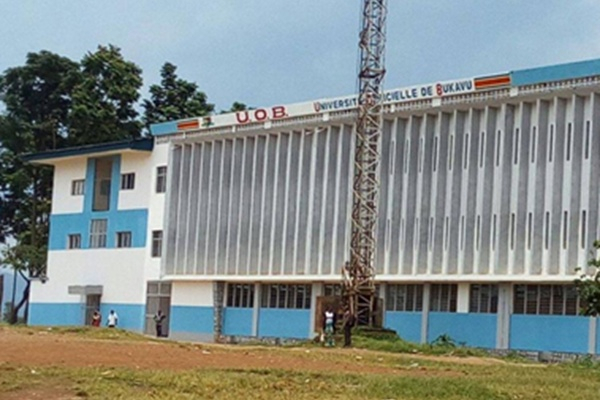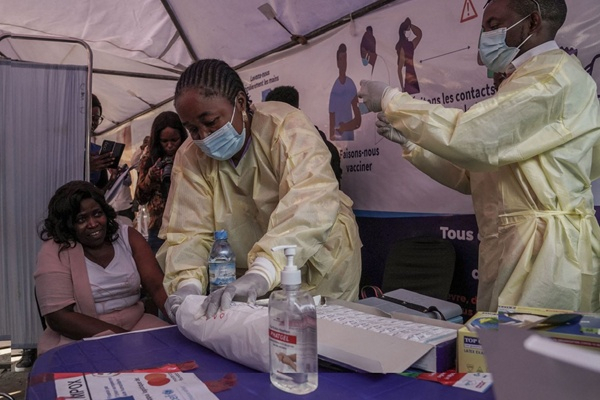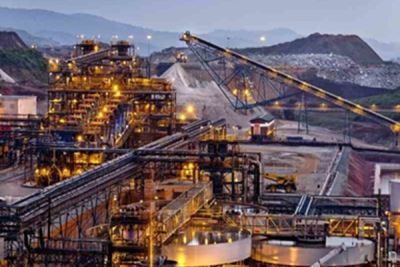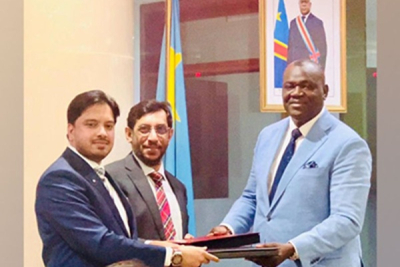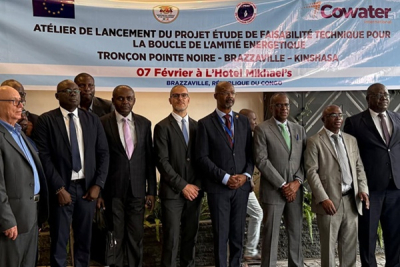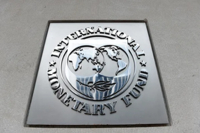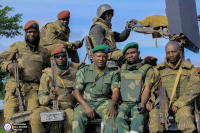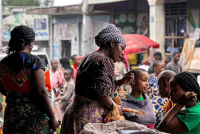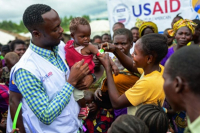
News (572)
As the conflict between the M3 rebels and the Congolese army persists in the eastern region, the DR Congo government has mandated open and distance learning in public and private universities. The decision was formalized on February 6, via a decree signed by Higher Education Minister Marie-Thérèse Sombo. It took effect the same day.
“Open and distance learning constitutes a mode of teaching accessible to all and it doesn’t in-person teaching,” the decree reads. “It leverages information and communication technologies (ICT) to provide educational content, carry out learning activities, and conduct exams.”
At the Council of Ministers meeting on February 7, Minister Sombo presented distance learning as a “suitable solution for ensuring the continuity of courses despite the Rwandan aggression.”
However, implementing this approach requires urgent action, including deploying digital platforms for online courses, helping teachers and students to appropriate digital tools, and establishing partnerships to strengthen digital training and infrastructure. Safe learning centers should also be set up.
A major barrier to the e-learning project could be power disruption in the eastern region, as many power facilities have been damaged. This threatens the supply chain; a situation that could make running e-learning platforms harder. Internet connection quality, essential for e-learning, also poses a challenge.
The Congolese authorities said they would set up a special commission to oversee the e-learning project to ensure adaptation to local realities and challenges from instability in certain provinces. The commission will also monitor and evaluate the impact of the measures, adjusting the strategy as needed.
While primarily an emergency response, the project could birth a more modern education system in the DRC. Increased use of digital technology could strengthen the sector's resilience and promote wider access to education, particularly in remote or conflict-affected areas.
This article was initially published in French by Olivier de Souza
Edited in English by Ola Schad Akinocho
During the February 7th council of ministers, the Democratic Republic of Congo (DRC) reported a drop in suspected Mpox cases nationwide, from 2,707 to 1,842 in the fourth week of the outbreak. "The trend indicates that the measures implemented to combat this epidemic are beginning to produce positive effects," the council’s minutes note.
The U.S. significantly helped the DRC tackle the crisis. The U.S. Agency for International Development (USAID) provided 50,000 doses of the Mpox vaccine and last year, the U.S. provided the African country $10 million to better handle the health situation.
In late January, Japan also contributed 50,000 doses of the LC16 vaccine and bifurcated needles. This was Japan’s first shipment out of three million doses requested by the DRC.
On February 11, the Ministry of Health announced that Canada would donate 200,000 doses of vaccine next week, facilitated by Gavi, the Vaccine Alliance. These vaccines will be distributed according to the Access and Allocation Mechanism established by Gavi, the World Health Organization (WHO), and other partners.
"The DRC expresses its gratitude to the Government of Canada and Gavi for their partnership in providing 200,000 doses of Mpox vaccine. This demonstrates international solidarity in the fight against this epidemic," said DRC Health Minister Samuel Roger Kamba.
Despite these efforts, concerns remain about managing the health crisis amid ongoing conflict in eastern DRC. "Although reported cases have stabilized, the deteriorating security situation has led many patients to leave treatment centers, increasing transmission risks," warned WHO Director-General Dr. Tedros Adhanom Ghebreyesus last week.
In August 2024, WHO declared Mpox a public health emergency of global concern. The African Centre for Disease Control and Prevention classified it as a threat to regional health security. By November, more than 629 deaths had been reported in the DRC due to the outbreak.
Olivier de Souza
The Kibali gold mine in the Democratic Republic of Congo (DRC) produced 686,000 ounces in 2024, down from 763,000 ounces in 2023, thus down 10% year-on-year. Barrick Gold, the Canadian from which co-owns the mine, disclosed the figure on February 12, 2025.
Kibali thus fell short of the forecast of its owners for 2024. Indeed, Barrick Gold and its main partner, AngloGold Ashanti, had projected the mine’s output at 711,000 to 800,000 ounces. Barrick’s expectations were based on a 4% increase in the first half of 2024.
However, in H2 2024, the mine’s output dropped by 21% year-on-year. While Barrick has not officially explained this underperformance, AngloGold Ashanti attributed the third-quarter drop to lower gold grades in the processed ore.
This year, Barrick expects its attributable gold production to stand between 310,000 and 340,000 ounces, against 320,000 to 360,000 ounces anticipated in 2024. Bankable estimates that Kibali will produce between 688,000 and 755,000 ounces in 2025, down from its output in 2023.
Barrick and AngloGold each hold a 45% stake in Kibali.
Emiliano Tossou
The Kibali gold mine contributed $316 million to Barrick Gold’s turnover last year. Kibali’s contribution to its co-owner’s revenues shot up 30.8% yearly. The mine’s contribution to Barrick’s operating income also grew, by 15.8%, to $450 million in 2024.
Kibali, located in the Democratic Republic of Congo (DRC), did better than Barrick’s Malian gold mine, Loulo-Gounkoto. Over the period reviewed, the Malian asset also contributed more, but in lower proportions–respectively 8.25% and 2.25% more on the sales revenue and operating income fronts.
This financial uptick comes despite a decline in production levels. Indeed, Kibali produced just 686,000 ounces (21.34 tonnes) of gold in 2024, the lowest output since 2019 when production peaked at 813,000 ounces. For the first time since then, Kibali has been surpassed by Mali's Loulo-Gounkoto mine, which produced 22.5 tonnes of gold, snatching the Congolese mine’s crown as Africa’s top producer.
Barrick Gold attributes the production drop at Kibali to lower gold content within the ore extracted. The average gold content per tonne processed fell from 3.8 grams in 2019 to just 2.8 grams in 2024. Additionally, the proportion of ore deemed non-commercially viable increased from 74% in 2022 to 78% in 2024.
Partial positive impact
Though Kibali’s output decreased, Barrick Gold paid more royalties to the Congolese government in 2024 than it ever did since 2019: $39 million. Over the past six years, Barrick paid $169 million in royalties to the DRC, reflecting taxes on extracted gold and duties on mining area usage. Barrick Gold owns 45% of the Kibali mine.
As for Kibali’s overall impact on Barrick’s net profit—an important metric for corporate income tax calculations—this remains uncertain and heavily influenced by declared expenses. Barrick reported investing $116 million in its operations last year, the highest since 2019. The figure amounts to 26% of all investments made since 2020. However, cash operating costs have also surged to a record average of $905 per ounce produced, despite the lowest production levels since the mine opened.
Barrick Gold did not directly explain why operating costs and capital expenditure rose but this reflects a broader trend of rising production costs that have escalated annually since 2021. Investments aimed at reducing these costs include the installation of a new 16-megawatt solar power plant on-site.
This article was initially published in French by Georges Auréole Bamba
Edited in English by Ola Schad Akinocho
General Technologies (GT), an Indian technology solutions provider, will invest in the DR Congo's digital infrastructure. In a press release issued on Feb 6, 2025, HT Syndication, a subsidiary of Indian media group HT Media Ltd., said GT successfully signed a memorandum of understanding (MoU) for the project with the Congolese government.
The ambitious plan calls for a total investment of $1 billion by 2028, earmarked for constructing three state-of-the-art data centers, developing satellite infrastructure to improve connectivity in remote areas, extending 3G and 4G networks, and deploying 38,000 km of fiber optic cable
"This memorandum of understanding, exclusive to General Technologies (GT), includes an advisory position within the Ministry of Telecommunications. The Congolese government undertakes to provide visas, administrative offices, and land to enable GT to complete the projects by December 31, 2028", the press release stated
As the MoU is a preliminary agreement, definitive agreements are needed to solidify the investment framework; especially since projects sometimes remain at that stage in the DRC. However, if it goes through, the investment could "revolutionize" the DRC's underdeveloped telecoms infrastructure, as GT's promoters claim
Last year, the DRC's telecoms infrastructure index stood at 0.1591 out of 1, according to the UN's Department of Economic and Social Affairs (DESA). The indicator is a key component of the e-government development index (EGDI), which stood at 0.2715 out of 1. Both figures were behind the averages for Central Africa (0.3354), Africa (0.4247), and the world (0.6382), positioning the DRC at 179th out of 193 nations.
This article was initially published in French by Isaac K. Kassouwi
Edited in English by Ola Schad Akinocho
Cowater International, a firm based in Ottawa, CA, was picked to conduct the feasibility for a crucial link of the Energy Friendship Loop that connects Angola, Congo Brazzaville, and Congo Kinshasa (DR Congo). The sub-project–a power line–will go from Pointe Noire to Brazzaville (Congo). The related feasibility was launched on January 7, 2025, in Brazzaville.
Funded by the European Union (EU), the Energy Friendship Loop aims to connect Inga (DR Congo) to Cabinda (Angola), then to Pointe-Noire and Brazzaville (Republic of Congo), before looping back to Kinshasa and Inga in the DRC.
A year ago, a progress report indicated that feasibility studies, detailed designs, and tender documents were already complete for the 307 km Inga-Cabinda-Pointe Noire segment. The same source added that a 400 kV line had already been laid between Inga and Kinshasa. Now, the focus has shifted to designing and tendering the Pointe-Noire-Brazzaville-Kinshasa segment.
Once all feasibility studies for the project are done, the step will be securing funds and picking construction firms. For now, however, no implementation timetable has been released.
A lever for energy development
The Energy Friendship Loop mainly aims to secure electricity supplies for Brazzaville, Kinshasa, and Cabinda by linking these cities to major power generation hubs like Inga and Pointe-Noire.
According to the African Development Bank (AfDB), Angola has 1.5 GW of unused clean hydropower capacity, forecast at 3.5 GW by 2027. However, the Cabinda province is isolated from Angola's national grid. Thus, Angolan authorities believe connecting with Inga (DRC) is "the most viable short-term solution" to meet the province's energy needs.
It is worth noting, however, that even at full capacity (1,775 MW), the Inga dam struggles to meet local demand. The DRC, according to official figures, has an electrification rate of 21.5% – a situation that the Energy Friendship Loop could help address.
As for the European Union, it believes that the interconnection project will "constitute a major lever for the development of the electricity sector in Central Africa". Indeed, the project could foster more power projects or accelerate the long-stalled Inga III project.
This article was initially published in French by Pierre Mukoko
Edited in English by Ola Schad Akinocho
After its Council of Ministers of February 7th, the Democratic Republic of Congo (DRC) unveiled its strategy for mobilizing resources to address the conflict in the east. The fight between the Congolese army, M23 rebels, and Rwandan troops recently escalated.
The rebels presently occupy key cities such as Goma, the capital of North Kivu, and are advancing toward Bukavu, the capital of South Kivu. The Congolese government reports that over 3,000 people have been killed and thousands more wounded since the offensive began.
To finance the war effort, the government intends to tap into budgetary support from its existing program with the International Monetary Fund (IMF). The amount, undisclosed at the moment, "could be allocated to social investments with a direct impact on the military and their dependents," according to the Council’s' minutes.
The plan is to present this proposal to the IMF mission, which is expected to arrive this month. On January 15, 2025, the IMF Executive Board approved a 38-month program combining the Extended Credit Facility (ECF) and the Resilience and Sustainability Facility (RSF), totaling $2.8 billion. This program aims to bolster macroeconomic stability, improve governance, and enhance the country's resilience to climate-related challenges. Kinshasa now faces the challenge of convincing the IMF that social investments benefiting the military and their families align with the program's broader objectives.
In his address to the nation on January 29, President Félix-Antoine Tshisekedi appealed to all economic sectors to contribute to the war effort. After the recent Council, it was revealed that dedicated bank accounts and a digital platform (www.solidariteest.com) have been set up to ease fundraising.
A special bonus for military and police personnel
Echoing the President's call, the Fédération des Entreprises du Congo (FEC) suggested setting up a fund to aid areas affected by the conflict, in addition to the contribution of one million dollars for the DRC Armed Forces (FARDC) from the state-owned Office de Gestion du Freight Multimodal (OGFREM).
According to the Council’s minutes, semi-public companies are also prepared to contribute through dividend advances. The document added that the Ministers for Telecommunications and Oil and Gas are tasked with proposing mechanisms to enable these sectors to participate in the war effort.
During the Council, the government adopted measures to cut institutional overheads and suspend certain public expenditures. Without specifying the exact amount, the government said it would mostly use the funds to increase the earnings of military, police, and security personnel and grant a special bonus to the FARDC, the Police, and other security services, starting this month.
This article was initially published in French by Pierre Mukoko
Edited in English by Ola Schad Akinocho
Responding to a call from President Félix-Antoine Tshisekedi, the Fédération des Entreprises du Congo (FEC), a major Congolese employers' organization, has proposed establishing an "economic support fund" to aid regions ravaged by the ongoing conflict in the eastern DRC. According to a communiqué released on February 6, 2025, the fund will be fueled by voluntary contributions from FEC members.
During his address to the nation on January 29, President Tshisekedi urged all sectors, including the private sector, to contribute to the war effort. “Our soldiers are fighting heroically in defense of our territorial integrity and sovereignty. They need our full support, whether moral, material, or logistical," he stated.
While the FEC statement doesn't specify how the funds will be used, the needs are multifaceted. Beyond bolstering the military's capacity to counter the M23 rebels, there's an urgent need to address the escalating humanitarian crisis and mounting economic fallout.
The recent escalation has displaced over 400,000 people, swelling the total number of people displaced by the conflict to over 5 million. Several sources number nearly 800 or more deaths, with thousands more wounded.
According to the FEC, the fighting disrupts supply chains by hindering the movement of goods and services. This increases the risk to investment by discouraging domestic and foreign capital and degrades the business climate by weakening the confidence of economic players, thereby undermining business productivity and competitiveness.
Moreover, the M3 rebels undermine efforts to tackle illegal mining, causing the central and local governments to lose more tax income.
Nevertheless, business is slowly resuming in Goma, which the rebels still occupy. However, widespread looting and business closures have likely inflicted substantial losses on businesses and small shops.
Georges Auréole Bamba
Food prices have soared in Goma since M23 rebels and their Rwandan backers took over the town on January 26, 2025. A report by ActionAid published on February 3, indicated that essential goods, including flour, beans, and oil, have seen price increases of 18% to 160% within a week.
The road blockades, a key factor in the price surge, have disrupted food supplies to the city, nested in the eastern part of the Democratic Republic of Congo (DRC). According to ActionAid, nearly 90% of Goma's food supply comes from neighboring regions now inaccessible due to the conflict.
A resident quoted by Radio Okapi reported improvements since February 4. “Roads reopened, and large quantities of food can come from Minova, Masisi, and Rutshuru.” The same source, however, added that household purchasing power has been diminished. “Banks are closed, several services are not operational, several shopkeepers have been looted and many residents reduced to unemployment,” the resident said.
The resulting food crisis threatens hundreds of thousands with malnutrition, with women and children at greatest risk. The World Food Programme (WFP) estimates that 4.5 million children under five and 3.7 million pregnant and breastfeeding women could suffer acute malnutrition in the next five months if things remain unchanged.
Olivier de Souza
The Democratic Republic of Congo (DRC) could be severely affected by the looming shutdown of the U.S. Agency for International Development (USAID). The DRC is one of the top African recipients of U.S. aid.
On February 3, Elon Musk, as Head of the U.S. Government Department of Efficiency, announced the USAID’s potential closure. A few days prior, President Trump had issued an executive order freezing U.S. foreign aid for 90 days, except for Israel, Egypt, and emergency food assistance. Secretary of State Marco Rubio has been appointed as the USAID’s interim director to address internal "insubordinations" that hindered a planned review of the agency's activities. Citing Rubio, several media outlets reported that the Agency’s actions sometimes misaligned with the United States’ strategic priorities.
Potential Repercussions on DRC
The DRC heavily relies on aid from the U.S. In a statement released on January 23, 2025, the U.S. embassy said the USAID has channeled over $6 billion in humanitarian and development assistance to the DRC over the past decade, averaging $600 million annually. This is nearly double the infrastructure investments slated to flow from the Sicomines contract, a controversial deal involving Chinese entities, until 2040.
"As the largest bilateral donor, working in 25 of the DRC's 26 provinces, USAID advances health and education, protects the environment, provides vital humanitarian assistance, and supports economic growth that benefits all citizens," the embassy’s statement reads.
In 2024, before Trump was elected, USAID announced an additional $424 million in aid, including $414 million for humanitarian assistance related to conflict and displacement, and $10 million for health initiatives targeting the Mpox epidemic. The agency also provided 50,000 doses of the Mpox vaccine to the DRC, which is the country hardest hit by the disease. These commitments brought total U.S. humanitarian aid to the DRC to over $838 million for fiscal year 2024.
While it is still too early to know if the USAID will effectively shut down, the potential consequences for the DRC are significant. This could disrupt essential services for millions of people who depend on USAID aid.
In an interview with French media RFI, Jacques Mukena, a governance and economics specialist at the Ebutleli Congolese Institute, suggested that the U.S. may seek to negotiate terms for maintaining aid, potentially requiring the DRC to “align more closely with U.S. strategic interests”. "They may demand a reduction in Chinese influence, particularly over control of strategic minerals," Mukena added.
This article was initially published in French by Louis-Nino Kansoun
Edited in English by Ola Schad Akinocho
More...
The Democratic Republic of Congo (DRC), heavily reliant on biomass for cooking, is embarking on an ambitious journey to embrace clean cooking technologies. With over 95% of households still using solid fuels, the government's Energy Compact targets a 30% adoption rate by 2030, benefiting 40 million people.
To achieve this, the DRC government intends to launch a national clean cooking strategy by the end of 2025. This strategy aims to foster the use of liquefied petroleum gas (LPG), improved cookstoves, and electric cooking. Only 14% of the population of Kinshasa, the capital, currency use LPG, around 250,000 households. The authorities aim to increase this to 1.2 million households by 2030.
However, significant obstacles stand in the way. These include a lack of storage and distribution infrastructure, limited availability of gas cylinders, and high LPG costs, trading at around $5 per kilo—meanwhile, a 40 kg bag of charcoal costs around $26.
The government is banking on private sector involvement to surmount these challenges. Incentives, such as duty exemptions on clean cooking equipment and establishing a regulatory framework conducive to investment, are under consideration to structure a viable market.
With a population exceeding 100 million and a clean cooking technology adoption rate of just 1%, the DRC has one of the lowest penetration levels globally, despite the widespread use of biomass for cooking posing significant environmental and health risks. It heightens the country's ecological vulnerability, while indoor air pollution causes respiratory and cardiovascular diseases, particularly affecting women and children. Official figures estimate the economic costs of this pollution at $13.6 billion annually, with lost productivity from firewood collection adding another $16.1 billion.
Olivier de Souza, Ecofin Agency
The United Nations Children's Fund (UNICEF) has issued an urgent appeal for $22 million to assist 282,000 children affected by the escalating conflict in the eastern Democratic Republic of Congo (DRC).
"UNICEF is launching an urgent appeal for $22 million to provide emergency assistance to 282,000 children in eastern DRC, as violence intensifies. We need the parties to the conflict to stop the escalation of armed violence, which is only exacerbating the suffering of children and worsening the already appalling humanitarian conditions," stated Jean-François Basse, UNICEF's interim representative in the DRC.
The organization has reported a troubling increase in the number of children separated from their families or unaccompanied, heightening their vulnerability to abduction, forced recruitment, and sexual violence.
The funds from this appeal will help address urgent humanitarian needs, including providing access to clean drinking water, sanitation facilities, medical supplies, treatment for malnutrition, and child protection services.
UNICEF notes that instability in North and South Kivu has displaced 658,000 people in the past three months, including 282,000 children.
Olivier de Souza
On January 24, 2025, Ivanhoe Mines, a major mining operator in the Democratic Republic of Congo (DRC), successfully raised $750 million on international markets, exceeding its initial $600 million target. The funds come as Rwanda-backed M23 rebels escalate hostilities in eastern DRC.
The funds are repayable over five years at a 7.875% interest rate. Though steep compared to global benchmarks, this rate undercuts borrowing costs for many Africa-focused firms. Investors could have been deterred by the ongoing security crisis in the East, especially since the recent operation is partly guaranteed by Kipushi Holdings, one of Ivanhoe’s subsidiaries in DRC.
Several factors could explain the successful fundraising, including the strong demand for zinc and copper, which Ivanhoe extracts in DRC. Also, Copper futures on the London Metal Exchange (LME) have climbed steadily, reflecting tightening global supply chains. Another reason is that Ivanhoe and its subsidiaries have a good borrowing track record.
The funds raised will primarily fuel Ivanhoe’s ambitious expansion at its Kamoa-Kakula copper complex, where 2025 investments are projected between $1.42 billion and $1.67 billion. By contrast, the Kipushi zinc mine—now operational after a $185 million overhaul—is forecast to receive only $25 million for capacity upgrades.
This marks Ivanhoe’s latest in a series of strategic financings. In 2023, Rawbank extended an $80 million loan (since repaid), while FirstBank’s Congolese unit provided $50 million due in May 2025. Last summer, Trafigura Asie and CITIC Group (Ivanhoe’s largest shareholder, with a 22% stake) contributed $60 million via prepayment deals tied to future mineral output.
It remains to be seen what will happen to the value of the shares in the recent $750 million loan, listed on several European and American stock exchanges. In early January, Ivanhoe tempered shareholder enthusiasm by announcing lower-than-expected copper production forecasts, while raising its capital expenditure forecasts compared with estimates made three months earlier. Its communication to investors, scheduled for the close of trading on February 19, will hence be closely scrutinized.
This article was initially published in French by Georges Auréole Bamba
Edited in English by Ola Schad Akinocho
The Foreign Affairs Minister of the Democratic Republic of Congo (DRC), Thérèse Kayikwamba Wagner, wrote a letter to three international soccer clubs, asking them to stop promoting Rwanda as a tourist destination. The clubs are Arsenal, Bayern Munich, and Paris Saint-Germain (PSG).
"Rwanda is waging a murderous war in eastern Congo, forcing more than 500,000 people to flee their homes this year. It is unacceptable that a regime involved in such atrocities should benefit from a positive image through partnerships with world-renowned soccer clubs," the Congolese official wrote in her letter.
Kayikwamba Wagner further suggests that Rwanda's "Visit Rwanda" campaign may be funded by the illegal exploitation of mining resources from the DRC. She references a report by the UN Panel of Experts, which claims that at least 150 tonnes of coltan have been fraudulently exported to Rwanda from the DRC.
"Rwanda's plundering of Congolese mineral resources represents a billion dollars injected into the Rwandan economy. Rather than funding the economic development of the DRC, these revenues are used to finance expensive sponsorship deals with European soccer clubs," she argued. "The DRC would like you to put an end to these blood-stained sponsorship agreements with an aggressor country. If not for your conscience, do it for the victims of Rwandan abuse."
The Congolese minister's appeal targets a crucial aspect of Rwandan soft power: sports. Rwanda has already established itself as a host for the Basketball Africa League, the NBA's only African tournament, and has been actively lobbying to host the first African Formula 1 Grand Prix since 1993.
This article was initially published in French by Servan Ahougnon (Ecofin Agency)
Edited in English by Ola Schad Akinocho






